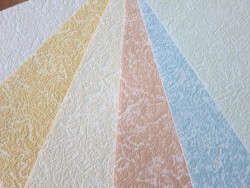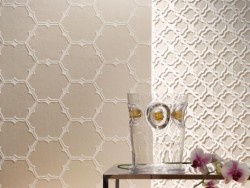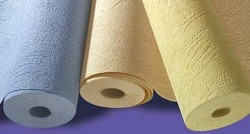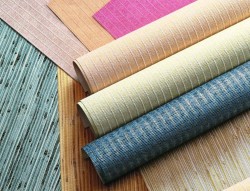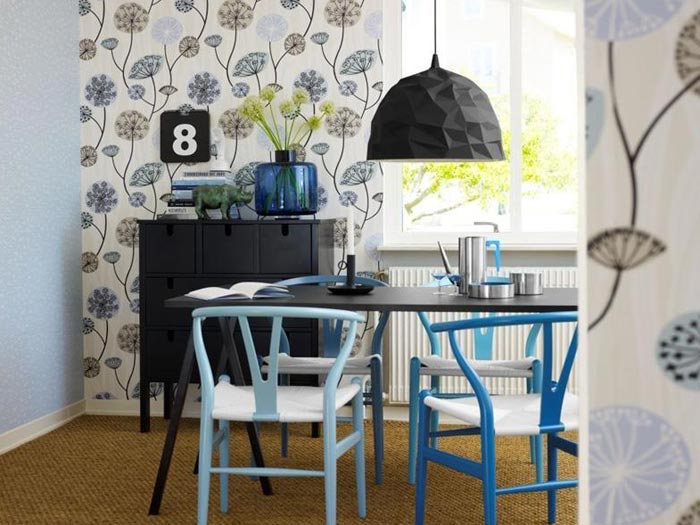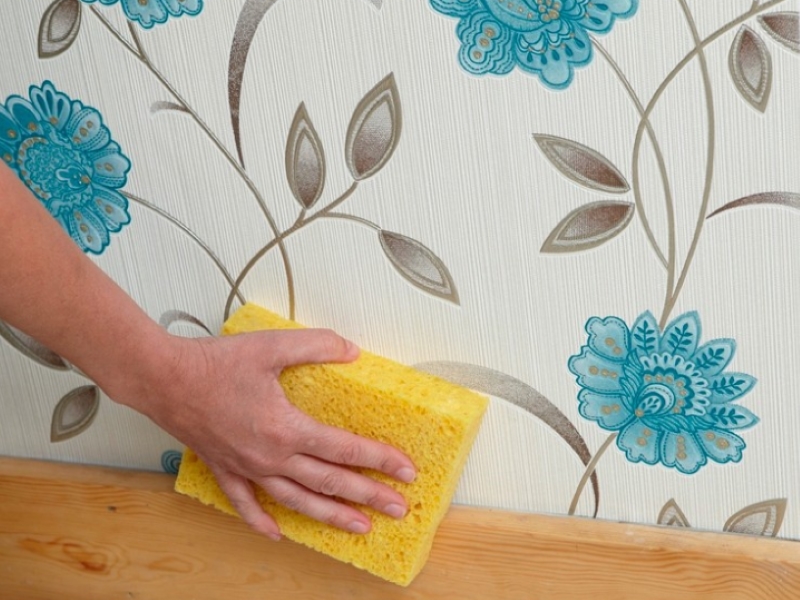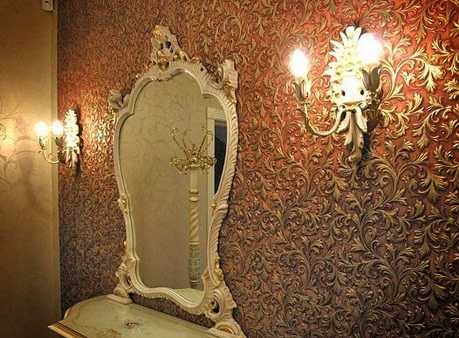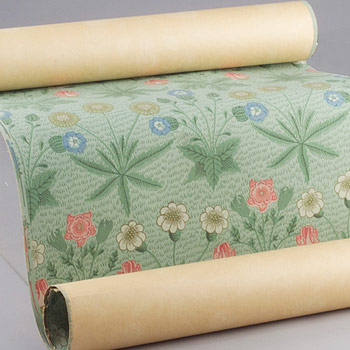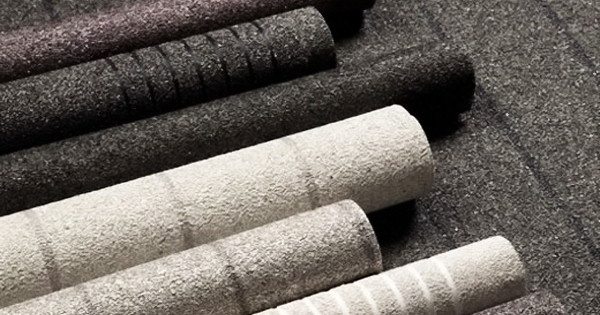Non-woven wallpaper: selection, sticking and painting
Non-woven wallpaper - one of the most popular today decoration materials for walls. All this thanks to the huge range of such wallpapers and their advantages, because, among other things, they even can be painted and repainted several times, and the interior in the room can be updated very quickly and without much effort. But even despite the enormous popularity of this coating, today not everyone who is going to carry out repairsknows what their Main advantages, how to choose non-woven wallpaper and how to paste them.
First you need to figure out what is non-woven. This is a material based on cellulose fibers, which retains almost all the properties of paper, but at the same time it is more durable and durable. Wallpaper can be either purely non-woven, or non-woven, if a coating of another material is used on top.
The benefits of non-woven wallpaper
Among the main advantages of this type of coating, the following should be highlighted:
 non-woven wallpaper is enough thickTherefore, they can mask small cracks and bumps on the walls;
non-woven wallpaper is enough thickTherefore, they can mask small cracks and bumps on the walls;- fire safety and fire resistance;
- if wallpaper is used for painting, then easy to change color cover or repair it in case of damage;
- pure non-woven wallpaper able to pass air and moisture, which means they will maintain an optimal microclimate in the apartment. True, if a vinyl layer is applied on top, then all these properties are nullified;
- the vinyl layer on the wallpaper is able to absorb dust, it does not fade, and the appearance of the wallpaper will always remain at its best;
 during installation, these wallpapers are also quite convenient, because they do not stretch and do not tear, Yes, and you need to glue the wall, and not the canvas of wallpaper;
during installation, these wallpapers are also quite convenient, because they do not stretch and do not tear, Yes, and you need to glue the wall, and not the canvas of wallpaper;- coating can glue on absolutely any surface: concrete, drywall, plaster, chipboard, etc .;
- such wallpaper easy to care, and they can be washed even with a rag or vacuum cleaner: neither the vinyl coating nor the paint layer will be affected;
- if you decide get rid from this coverage then it will do not difficult, and you don’t have to painfully tear it off the walls.
The disadvantages of non-woven wallpaper
There are not so many shortcomings, but still they are, and they need to be taken into account if you have chosen this type of coverage for your home. So, the main disadvantages are:
 if the wallpaper has a too embossed surface, then top layer may be damaged. Keep this in mind if you have animals or small children;
if the wallpaper has a too embossed surface, then top layer may be damaged. Keep this in mind if you have animals or small children;- they can dust accumulate, so you have to regularly clean the wallpaper;
- the price of non-woven wallpaper is slightly higherthan on other types of wallpaper, which is explained by the possibility of their multiple staining. Nevertheless, do not stop your choice on materials of dubious quality from unknown manufacturers in an attempt to save.
How to choose non-woven wallpaper?
To decide which coating is most suitable for a particular room, you need to study the characteristics of all possible types of non-woven wallpaper. All of them can be divided into two main types:
 wallpaper in which flizelin - independent material. In this case, the wallpaper consists of several layers of non-woven fabric, the uppermost of which, as a rule, has some kind of relief structure. Such a material after pasting can be painted several times;
wallpaper in which flizelin - independent material. In this case, the wallpaper consists of several layers of non-woven fabric, the uppermost of which, as a rule, has some kind of relief structure. Such a material after pasting can be painted several times;- non-woven wallpaper - a material in which a layer of another material is used on top of the non-woven layer: paper, textile, but most often vinyl. Vinyl wallpapers on a non-woven basis retain some of the advantages of non-woven: ease of installation and the ability to hide some irregularities in the walls, but we can’t talk about characteristics such as breathability or environmental friendliness. Such wallpapers can be perfectly smooth, embossed or foamed and can also be used as wallpaper for painting.
Wallpaper color
Non-woven wallpaper can initially be:
- colored;
- white.
 Unpainted wallpapers are intended for subsequent decoration, but it should be remembered that the more layers of paint are applied to the wallpaper, the less noticeable the relief. Some colored wallpapers can then also be painted, but it is desirable that the color of the paint be close to the original. Wallpaper for painting is great for rooms such as a kitchen or hallway, where the walls are constantly exposed to some kind of impact, and with the help of painting you can not only decorate the surface, but also quickly get rid of possible defects.
Unpainted wallpapers are intended for subsequent decoration, but it should be remembered that the more layers of paint are applied to the wallpaper, the less noticeable the relief. Some colored wallpapers can then also be painted, but it is desirable that the color of the paint be close to the original. Wallpaper for painting is great for rooms such as a kitchen or hallway, where the walls are constantly exposed to some kind of impact, and with the help of painting you can not only decorate the surface, but also quickly get rid of possible defects.
Depending on the type of surface, non-woven wallpaper can be:
 monotonous, designed for painting with latex or acrylic paints;
monotonous, designed for painting with latex or acrylic paints;- smooth with a ready-made pattern;
- with silkscreen printing;
- embossed.
Wallpaper texture is better to choose depending on the interior of the room and your own design requirements. So, large patterns and a noticeable relief are able to hide some surface defects of the walls. But if the interior is done in soft colors, then it is better to choose a smaller picture. It should also be remembered that the more pronounced the pattern on the wallpaper, the more times they can be repainted without loss of relief.
Web width
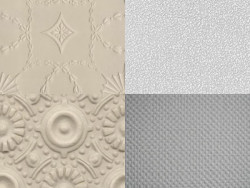 Another parameter that you should pay attention to when choosing a non-woven wallpaper is their width. So, on sale there are mainly wallpapers with a width of 0.5 and 1 m. For large premises, it is better to choose wide wallpapers to simplify the installation process as much as possible and reduce the number of joints to a minimum. In small rooms it is better to glue narrow wallpaper, as there will be less hassle and less waste.
Another parameter that you should pay attention to when choosing a non-woven wallpaper is their width. So, on sale there are mainly wallpapers with a width of 0.5 and 1 m. For large premises, it is better to choose wide wallpapers to simplify the installation process as much as possible and reduce the number of joints to a minimum. In small rooms it is better to glue narrow wallpaper, as there will be less hassle and less waste.
Well, and of course only get one lot of wallpaperso that their pattern and color is identical. Give preference to trusted and reputable manufacturers.
How to glue non-woven wallpaper?
FROM sticking these wallpapers almost anyone can handle it, because the process is as simple as possible. So, first you need to make sure that everything necessary tools is available, and this:
 roulette;
roulette;- level;
- knife;
- pencil;
- long pile roller;
- a spatula for rolling and a brush for smoothing wallpaper;
- metal spatula;
- container for water and glue;
- sponge;
- wallpaper itself in the required quantity: first you need to measure the height and width of the walls in order to understand how many rolls you need. It is better to take a wallpaper with a small margin, so that later there would be no difficulty in finding material of the same batch.
Surface preparation
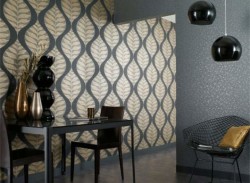 Non-woven wallpaper, although they can hide some of the unevenness of the walls, but require the maximum surface uniform colorso that in the future, through the layer of new wallpaper, the color of the old wall covering is not enlightened.
Non-woven wallpaper, although they can hide some of the unevenness of the walls, but require the maximum surface uniform colorso that in the future, through the layer of new wallpaper, the color of the old wall covering is not enlightened.
Old wallpapers must be removed with a spatula, you can moisten them first. Old paint also needs to be disposed of, in which case sandpaper may come in handy. After the wall has been processed, the surface is best primed. If there are strong bumps or cracks on the walls, then it is better to get rid of them first and align the surface carefully. Also, before gluing remove all sockets and switches.
Non-woven wallpaper glued butt, and as a result, after installation, the surface is perfect, but to achieve such an effect you need to try a little and mark the wall. So, from the corner of the room with the help of a tape measure, a distance equal to the width of the wallpaper roll is laid aside. Then, using a laser level or a plumb line, a strictly vertical line is drawn, a segment of exactly the same width is laid off from it, a vertical line is drawn again, etc. Such marking will help to stick the wallpaper on the walls as evenly as possible.
Wallpaper and glue preparation
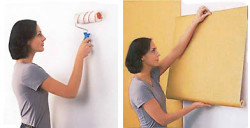 Before gluing, it is better to cut the wallpaper in sufficient quantities for all the walls of the room. If there is a large pattern that needs to be combined correctly, the process is a little complicated, but manufacturers often indicate on the package how many centimeters should be left for the allowance for joining the pattern. By the way, it is not superfluous to measure the height of the walls at different points in the room before cutting wallpapers, with a step of 30-50 cm, and then take into account the results obtained when cutting wallpapers.
Before gluing, it is better to cut the wallpaper in sufficient quantities for all the walls of the room. If there is a large pattern that needs to be combined correctly, the process is a little complicated, but manufacturers often indicate on the package how many centimeters should be left for the allowance for joining the pattern. By the way, it is not superfluous to measure the height of the walls at different points in the room before cutting wallpapers, with a step of 30-50 cm, and then take into account the results obtained when cutting wallpapers.
Before cutting the wallpaper you need to wash the floor well or cover it with plastic wrap. Then you need to lay out the wallpaper face down, measure the required length taking into account the allowance for the docking pattern, make a notch, once again check whether the pattern of the neighboring panels coincides, and only then cut it off.
For gluing non-woven wallpaper you must use special glue. It is not difficult to prepare it, and for this it is necessary to follow the instructions on the packaging: glue powder is carefully poured into a certain amount of water, constantly stirring. After this, the glue is left briefly so that it swells.
Wallpapering
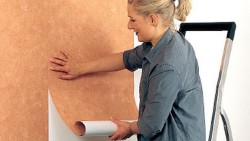 Glue is applied to a section of the wall, the width of which is equal to the width of the roll of wallpaper, but some experts advise to smear a slightly wider part of the wall to provide the edges with maximum fit. By the way, before starting, carefully read the manufacturer's instructions, because in some cases it will be necessary to smear the wallpaper itself. In any case, the adhesive must be applied as evenly as possible.
Glue is applied to a section of the wall, the width of which is equal to the width of the roll of wallpaper, but some experts advise to smear a slightly wider part of the wall to provide the edges with maximum fit. By the way, before starting, carefully read the manufacturer's instructions, because in some cases it will be necessary to smear the wallpaper itself. In any case, the adhesive must be applied as evenly as possible.
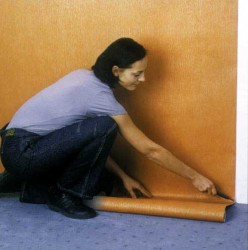 It is better to start gluing the wallpaper from top to bottom, gently pressing the canvas against the wall, and smoothing it with a brush or roller from the center to the edges. If you glue wallpaper with a pronounced texture, then it is better to use a wallpaper roller, and press it without fanaticism, so as not to damage the surface. After gluing, the excess parts of the wallpaper are cut from below and above, leaving 2-3 cm under skirting boards. It is convenient to cut off the excess with a spatula and knife, and it is better to move the spatula to the distance of the wallpaper strip so that the cut line is as even as possible. Now with a slightly damp sponge, it is necessary to wash off the glue residues, otherwise after drying they will give a characteristic shine.
It is better to start gluing the wallpaper from top to bottom, gently pressing the canvas against the wall, and smoothing it with a brush or roller from the center to the edges. If you glue wallpaper with a pronounced texture, then it is better to use a wallpaper roller, and press it without fanaticism, so as not to damage the surface. After gluing, the excess parts of the wallpaper are cut from below and above, leaving 2-3 cm under skirting boards. It is convenient to cut off the excess with a spatula and knife, and it is better to move the spatula to the distance of the wallpaper strip so that the cut line is as even as possible. Now with a slightly damp sponge, it is necessary to wash off the glue residues, otherwise after drying they will give a characteristic shine.
The next sheet of wallpaper is glued back to back with the previous one: after drying, the wallpaper does not shrink, so there will be no gaps between them. The whole installation process is the same, but you need to make sure that the pattern on the two canvases matches. After gluing, we weld the joint with a roller, remove excess glue, and proceed to gluing a new strip.
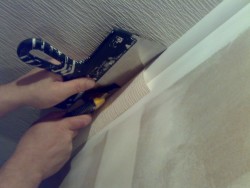 It is not recommended to glue the whole canvas into corners, since in rare apartments these corners are strictly straight and ideal, otherwise unnecessary wrinkles and other defects will occur. One strip of wallpaper must be glued so that it goes onto the other wall of the corner with an overlap of 2 cm. On the other side, the strip of wallpaper is also glued with a slight overlap, and then the excess is removed so that the length of the wallpaper rests against the corner. It is worth noting that the corner itself must be carefully smeared with glue.
It is not recommended to glue the whole canvas into corners, since in rare apartments these corners are strictly straight and ideal, otherwise unnecessary wrinkles and other defects will occur. One strip of wallpaper must be glued so that it goes onto the other wall of the corner with an overlap of 2 cm. On the other side, the strip of wallpaper is also glued with a slight overlap, and then the excess is removed so that the length of the wallpaper rests against the corner. It is worth noting that the corner itself must be carefully smeared with glue.
How to paint non-woven wallpaper?
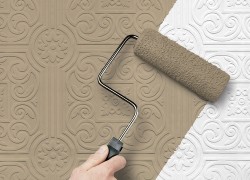 At the first painting of the wallpaper, you must wait until they are completely dry, and subsequently you can repaint the surface when you feel like it. Better to use for painting. latex-based aqueous dispersion composition: This paint is safe, environmentally friendly and dries quickly.It is better to apply it with a roller: foam or with a long pile, in order to better paint the relief of the wallpaper.
At the first painting of the wallpaper, you must wait until they are completely dry, and subsequently you can repaint the surface when you feel like it. Better to use for painting. latex-based aqueous dispersion composition: This paint is safe, environmentally friendly and dries quickly.It is better to apply it with a roller: foam or with a long pile, in order to better paint the relief of the wallpaper.
 The process of painting non-woven wallpaper is not much different from ordinary wall painting. It is important if you color the paint, it is better to immediately prepare a sufficient supply of it, otherwise it will be difficult to repeat the necessary shade in the future. Little by little the paint is poured into the tray, the roller is rolled out in it, the excess paint is squeezed out, and then the roller is drawn along the wall. It is better to apply the paint in a couple of layers to get a uniformly colored coating without white spots.
The process of painting non-woven wallpaper is not much different from ordinary wall painting. It is important if you color the paint, it is better to immediately prepare a sufficient supply of it, otherwise it will be difficult to repeat the necessary shade in the future. Little by little the paint is poured into the tray, the roller is rolled out in it, the excess paint is squeezed out, and then the roller is drawn along the wall. It is better to apply the paint in a couple of layers to get a uniformly colored coating without white spots.
Wallpaper in the corners, as well as joints with ceiling and floor skirting is better to paint over with a brush. Pre-skirting is better to paste over with construction tape, and after drying the paint to remove it. Now you need to wait a bit until the paint dries, and the process of gluing and painting is completed.
Finally
Today, non-woven wallpaper is a popular finishing material, due to its excellent performance properties. This is one of the few types of wallpaper that can be painted and repainted. In addition, this coating is able to hide some wall defects and provide them with an excellent appearance. To enjoy all the benefits of non-woven wallpaper, you just need to choose the right material and stick it correctly, and the above tips should help you with this.

